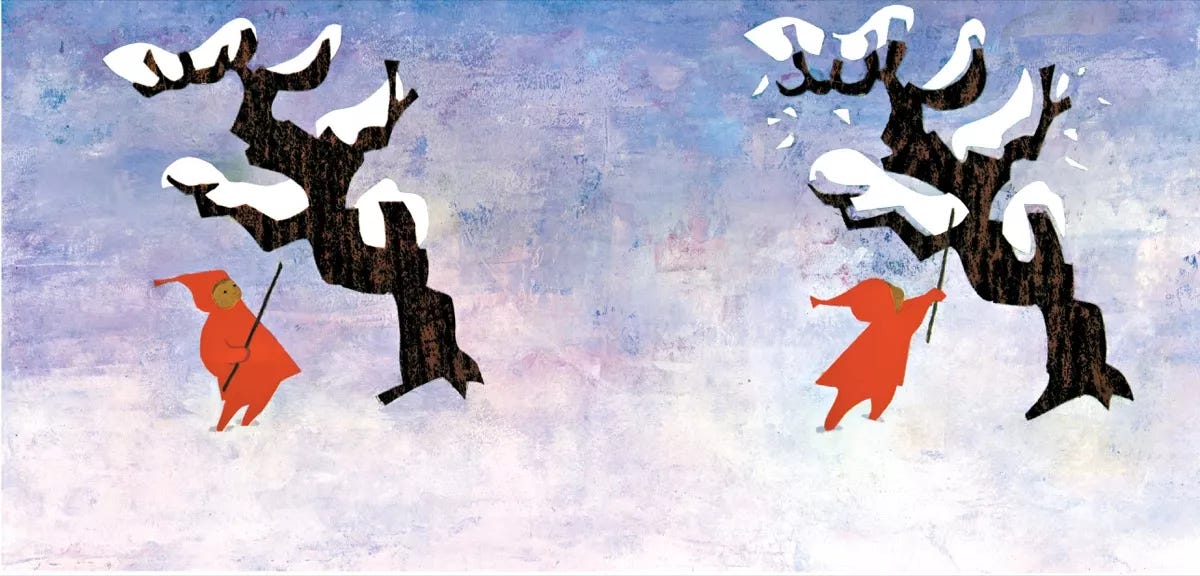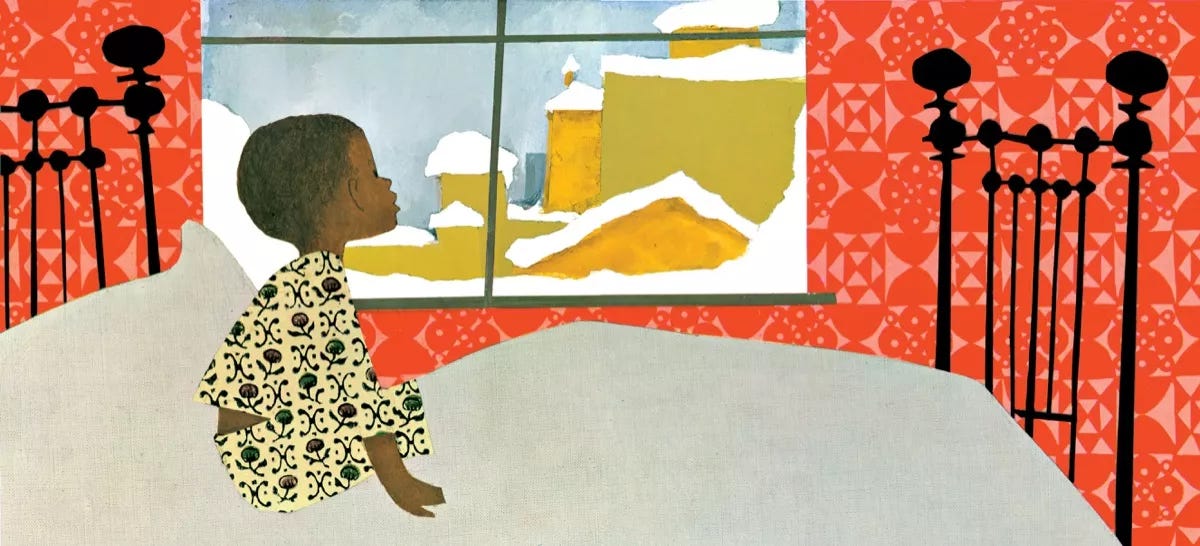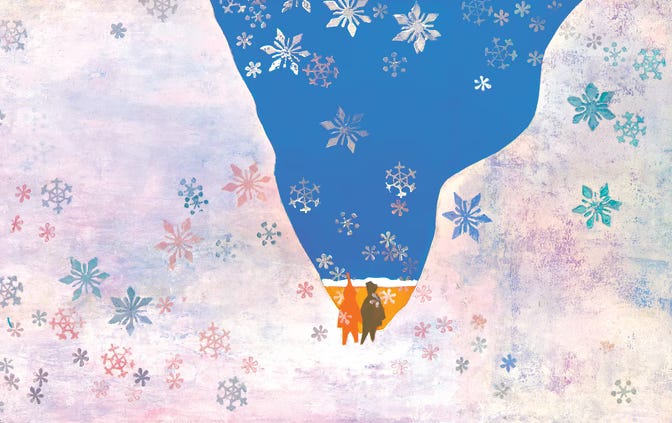bitterness and light
Love is an act of resistance
To support this newsletter, please subscribe to salt air and share!
This issue may get cut off in your email. To read in full, visit the Substack website or use the Substack app.
A new year: 2025. We’re in it now. And in many ways it’s been a dark start to the new year. Devastating fires in California. Bitter cold in many other places, including here in the Northeast. As I’ve said, I’d much rather a cold winter than no winter. But the combination—ice and fire—is certainly striking.
It’s been a slow start to the new year for me personally. But it’s OK to take your time. The calendar start to the year is sort of arbitrary anyway. And you can restart, start new things, “get back on track” whenever you want, whenever you need to.
Keep in mind that the days are getting longer.
Love is an act of resistance
We live under the governance of systems that idolize control over everything — including the planet — by small groups of elites. For centuries, these small dominant cliques did everything to make power work in their favor: they excluded whole groups of people based on their race, ethnicity, sex and gender identity, and other characteristics, from access to resources, and resorted to violence to keep this status quo with them at the top.
A dangerous concoction of patriarchy, racism and neoliberalism is at the heart of this system that has become our collective reality. In addition to our economic and political systems, it’s penetrated so deeply in our culture that it changed our worldview reinforcing its own narrative in the very things that make us human. . . . True love, radical love, is so powerful that it can dismantle a system whose only motivation is the accumulation of wealth and power.
In the USA in particular, it’s been a dark start to the new year—politically and socially. Anyone with sense, intelligence, awareness, and empathy can see how bad things are and will get—much worse and darker, even, than the first time DT was in power. This goes for the climate and public health as well as culturally, economically, and more. The steady march to the Right, into darkness—making people and the environment less safe, less stable, less equitable.
One of the most salient things that I’ve been struck by, as the far-right movement has gained power and the country becomes increasingly fascist, is what I see as this movement’s potentially defining feature: its sociopathic lack of empathy. It’s every man for himself. And every animal, every ecosystem.
But when one person—or animal or ecosystem—suffers, we all suffer. And saying NO to this, in whatever ways we can, is an act of resistance.
Caring for our friends and family members and neighbors—showing them we care, doing what we can—is an act of resistance.
Love is an act of resistance. Joy is an act of resistance.
We can—and must—organize. We can and must find—and make—space for joy and connection. Fear—of what will come or that we can’t affect change—and apathy and pessimism—waiting it out, putting our heads in the sand—are what fuels this kind of darkness. The individuals behind this movement—and yes, there are particular people who benefit (corrupt politicians, tech billionaires, gas, oil, and healthcare industry execs, and so on)—want us to be separate and to feel afraid and powerless; it makes it easier to control us while they pillage. But we’re not powerless.
And when I say we must make space for joy, I don’t just mean “find ‘pockets’ of joy” or take what you can get, “just try and get through the next four years” or focus on “self-care” in the sense that that term is used now. Taking care of yourself is obviously paramount, and sometimes small things are what you can reach for and implement in a moment—lighting a candle, taking a bath, walking outside for 30 minutes, etc. But I mean radically making space for joy and connection, saying NO I will not submit, saying YES I love other people and we are together in this, even if (even though) we have monumental challenges ahead of and all around us.
Don’t drop out, don’t go into a hole and wait for it to be over, don’t put your head in the sand. Obviously do what you gotta do, set boundaries, don’t drive yourself mad, take breaks, recognize what’s out of your control. But don’t lose hope for something better and a passion to bring it about; that is literally all we have.
. . . Love gives us hope. It helps us imagine the future we desire, and act together to bring it about. Like lovers dreaming about building their family home together, social justice activism empowers people to collectively imagine their future together — one of equality, freedom and peace. Love transforms collective imaginations. [quoted from “Love is Dismantling Systems of Oppression”]
How can we love in 2025? With Valentine’s day coming up, let’s examine what love really is. Especially in the face of darkness, challenges, and threats to people and the planet’s basic safety and wellbeing: Love is not a luxury. It is an essential tool and a necessity.
The Snowy Day, by Ezra Jack Keats, was published in 1962—the first full-color picture book to feature a black child as the protagonist. It won the Caldecott Medal in 1963.
A painter who worked in the comic industry and commercial art, Keats fell into children’s books when a publisher reached out and asked him to illustrate for her children’s division. In eight years, he illustrated some three dozen books, none of which prominently figured a minority character. “That wasn't a reflection of his life growing up, his neighborhood; it wasn't real,” said Clancy [curator at the Skirball Cultural Center in California, which exhibited “The Snowy Day and the Art of Ezra Jack Keats”]. By reflecting their lives in books, “he wanted children to feel a sense of self-acceptance.” If your story is important enough to tell, then you must be important too.
Keats illustrated The Snowy Day by combining layers of collage—including patterned fabrics and paper—and paint. His use of collage was ground-breaking and gives the book’s art a unique and striking depth and character.
The Snowy Day . . . marked a major shift in Keats’s artistic style. Prior to the book, Keats had always painted, which was how he originally tried to illustrate The Snowy Day. But, Clancy said, “[I]t wasn't working. It wasn't rich enough. It didn't reflect the grittiness of the city I suppose. He stumbled into collage, and that's how he illustrated every single book after it.” [quoted from “The Making of ‘The Snowy Day’”]
On the day of the women’s march in 2017, my mom was in the hospital in New York City, so she couldn’t march. But she told me that some of her nurses marched for her. And when I marched in Montpelier that day I was marching for her. That is powerful.
More soon. Thanks for reading!
♡ ETP




